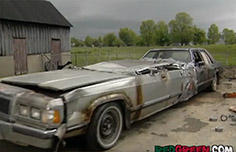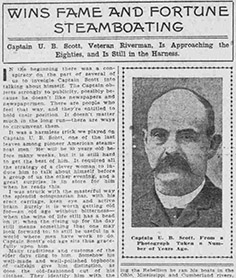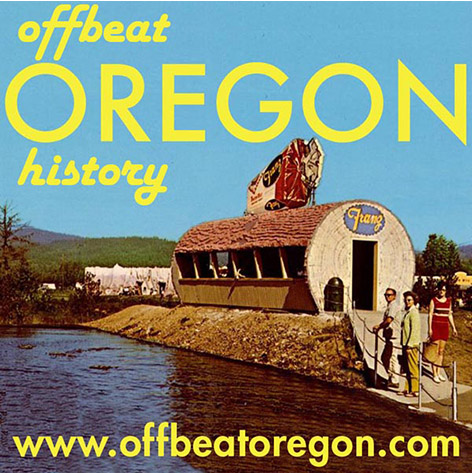CONTINUED FROM THE PRINT EDITION:
They laughed at Captain Scott's ugly boat ... at first
All in all, it was one ugly boat — so ugly that, as far as I have been able to learn, no photograph of it survives today. It’s entirely possible that none was ever made. If duct tape had been around in the 1870s, it would have been covered with the stuff, and probably would have involved at least one blue tarp somewhere in the upper works. One imagines the executives at the Oregon Steam Navigation Co. and the People’s Transportation Co. watching the construction with a mixture of amusement and pity. They were in for a nasty shock.
URIAH BONZER SCOTT was one of the most remarkable captains of industry ever to grace the Beaver State with his presence. He was born a country boy, born on a farm near Ironton, Ohio, in 1827; and he grew up playing by the Ohio River. It was the great era of steamboats, of course; and like lots of young riverside lads of the day (think Mark Twain) he was fascinated by them. In 1854, having saved up a few thousand dollars from his job as an ironworker, Scott bought a riverboat, learned to navigate it, and went into business making runs among the river towns of Ohio and Kentucky. Reinvesting his profits, he grew the business until, at the outbreak of the Civil War, the government requisitioned them. During the war, he ran them as troop transports and supply ships for the Union Army. After the war, he took his remaining fleet south and went into service on the lower Mississippi and Red rivers, shipping cotton from upriver farms and plantations to New Orleans. It was on this run, and especially on the Red River part of it, that he learned the value of a good shallow-draft hull, and how to build one. Then his bank went bust, and took his whole wad with it. So, Scott sold what remained of his operation and headed for Oregon, where he’d heard rumors about the need for good shallow-draft service on the upper Willamette River. That was in 1873. He arrived with an uncomfortably light purse, but he immediately saw what a tremendous opportunity there was for true Red River-style shallow-draft boats on the upper Willamette. There was tremendous demand for freight service to upriver farms, but the local riverboat companies combined ignorance with arrogance when it came to naval architecture — they didn’t know about true shallow-draft boats, and they didn’t consider the information worth acquiring. Which is how Scott ended up, in the summer of ’74, as we have seen him — trying to build a steamboat Red Green style, with only his investors’ $3,000 plus whatever he had left from his Red River operation.
THE RIVERBOAT BUSINESS Scott was plunging into had developed into a fairly cozy duopoly by the time he came on the scene. The bigger of the two riverboat lines, Oregon Steam Navigation Co., was a bloated and arrogant monopoly that had achieved total dominion over Columbia River runs by buying out most competitors and making anti-competitive deals with the rest. Like many such outfits, it took comfort in its bigness and didn’t regard its inflated ticket prices and haphazard service as a serious problem. What were customers going to do — protest? The other riverboat company was the People’s Transportation Co., which, as its populist-sounding name suggests, was originally a scrappy upstart steamboat line created to challenge Oregon Steam Navigation Co., and tap into the frustration of the traveling and freight-shipping public. But after a few successful years, it lost that competitive fire and made a cozy deal with OSN, which basically gave each company a monopoly on one of the two rivers — People’s on the Willamette, and OSN on the Columbia. With this arrangement in place, People’s had settled in as a sort of junior monopoly, and both companies worked to avoid any profit-killing competition in their routes. Thus, neither one of them had much of an interest in improvements to their service unless they wouldn’t cost money to implement. But building new boats would, of course, cost quite a bit of money, without adding much if any revenue — as things were, they still were able to charge farmers to transport their crops, just later in the year than they would have liked. It was a classic example of a market ripe for disruption, in which the disruptive innovation would have to come from outside. The established players weren’t interested.
|

There was definitely a market for the boats Scott was talking about, and Scott knew it well. A week after the Ohio was launched, everyone else in Portland knew it too.
ON THAT LAUNCH day, there were quite a few spectators and most of them were there for a laugh. The boat actually didn’t even look like it would float, any more than Red Green’s “mid-engined sports car” looked like it could merge onto the freeway — its hull was so shallow it almost looked like a foundation footing under the deckhouse. But into the river it went, and it floated like a water skipper. The watching riverboat men wondered aloud if the old dredge engine was powerful enough to allow it to make headway against the current. Scott rang for steam and left the dock; soon it was out of sight. It made way very nicely, too, floating level in the water and gliding through it smoothly and rapidly. You have to wonder if the other steamboat men started having second thoughts at this point. Could it be that this ignoramus from back east actually knew what he was doing? They got their answer a week or so later, when the Ohio got back from its run and they heard about its journey. It had made it all the way to Eugene City without so much as scraping bottom, taken on 70 tons of wheat, and steamed uneventfully back. Now it was ready to go and do it again. The secret of the Ohio’s success was that wide, flat, ugly hull. It could float on nine inches of water when it was empty, and with 100 tons of wheat on board, 18 inches. There are stories of boys out wading in the river having to be shooed out of the way so the ugly little steamboat could get through. The other steamboat men considered their designs shallow-draft, but they were water hogs compared with the Ohio. No other boat on the river could get within 40 miles of Eugene City even empty, to say nothing of getting back downstream with cargo. Oh, it hadn’t all been roses. The boat really was very janky. Several times the gas-pipe pitman arms had bent, locking the paddlewheel and forcing a laborious fix that probably involved a blacksmith’s hammer. Scott also found that the homemade paddlewheel had a tendency to work loose and separate from the boat. When this happened, they had to launch the boat’s tender and row after it, put a line on it, and laboriously tow it back to the wallowing Ohio to be re-mounted. It was tedious, and the boatswain didn’t always appreciate the exercise. But by the end of the freight season, Scott had made enough money to pay off his investors with enough left over to build a better boat — which he did, and that was the City of Salem. The City of Salem was larger, far superior in build quality, and drew even less water than the Ohio — Scott liked to say that it could run on a heavy dew. But it does kind of go without saying that, if Scott had felt the need to raise any more capital from investors to build it, he would have had all he could possibly need!
AS FOR THE competition, they found themselves in an uncomfortable spot. Caught utterly flat-footed, the two steamboat companies that had until this moment enjoyed a total duopoly on the river scrambled for their economic lives. Of course, they got busy building their own shallow-draft craft — but the only man in the state who really knew how to do that was now working for himself, so it took them a while to solve the engineering issues. Of course, they tried to buy Scott out. It must have been rather satisfying for Scott to have the same guys who’d blown him off when he asked for a job, and laughed him off when he was building the Ohio, now coming to him with hats in hands. But the time for that sort of thing was long past, and Scott was now in a position to raise all the capital he’d ever need. A third steamboat company had been born, and as Red Green would no doubt remark, its proprietor could certainly be depended upon to “keep his stick on the ice.”
|





